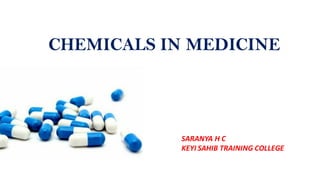CHEMICALS IN MEDICINES
- 1. CHEMICALS IN MEDICINE SARANYA H C KEYI SAHIB TRAINING COLLEGE
- 2. In pharmacology, a pharmaceutical drug, also called a medication or medicine, is a chemical substance used to treat, cure, prevent, or diagnose a disease or to promote well-being.
- 4. 1 ANALGESICS The term Analgesics encompasses a class of drugs that are designed to relieve pain without causing the loss of consciousness.
- 5. 2 ANTIPYRETICS The antipyretics are used to reduce a high body temperature and restore it back to normal. An antipyretic reduces fever by lowering a raised body temperature.
- 6. 3 ANTISEPTICS Chemical used in destroying disease causing microorganisms externally on wounds or (under medical supervision) taken internally to treat infection.
- 7. 4 TRANQUILLISERS A tranquilizer refers to a drug which is designed for the treatment of anxiety, fear, tension, agitation, and disturbances of the mind, specifically to reduce states of anxiety and tension.
- 8. 5 ANTACIDS An antacid is a substance which neutralizes stomach acidity and is used to relieve heartburn, indigestion or an upset stomach.
- 9. 6 ANTIBIOTICS Substance (such as penicillin) that destroys or inhibits the growth of other microorganisms and is used in the treatment of external or internal infections.









